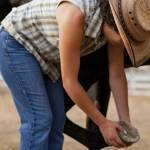Lame Horses: Examine Entire Hoof

While hoof abscesses can cause extreme pain in horses, and are often distressing to horse owners, they are a common cause of acute lameness in horses.
“Despite being so common, a recent report* pointed out that remarkably little up-to-date scientific information exists regarding factors contributing to the development of foot abscesses and which cases might be likely to encounter complications and prolonged treatment,” said Laura Petroski-Rose, B.V.M.S., a staff veterinarian for Kentucky Equine Research. “In fact, much of the data on hoof abscesses relies on personal opinion and experience rather than evidence-based medicine.”
As with many lamenesses, protracted treatment increases costs, veterinary visits, time off from training or competition, and quality of life.
To improve our understanding of hoof abscesses and to rapidly identify horses that might require prolonged treatment, a team of researchers retrospectively evaluated the medical records from 494 cases of hoof abscessation.** Key findings included:
- Abscesses occurred most frequently in the right front limb;
- In contradiction to popular belief, abscesses did not develop most frequently on the medial, or inner, aspect of the hoof but occurred equally on either side;
- While widely thought to occur more frequently in wet weather, abscesses were predominantly diagnosed between June and November in drier weather;
- The presence of a drainage tract and higher lameness score was associated with shorter treatment times; and
- Complications included cellulitis (infection of the skin and underlying tissues), osteitis (inflammation of the lining of the bones in the foot), hoof cracks, septic joints, and recurrence. Each of these prolonged treatment times.
“In terms of treatment, researchers found that antibiotic and nonsteroidal anti-inflammatory drugs, two medications frequently used in horses with infections, could actually be contraindicated. These medications prevent the abscess from maturing, thereby allowing the microorganisms responsible for the abscess to invade surrounding tissues,” Petroski-Rose shared.
To support overall hoof health, examine your horse’s feet daily; always call a veterinarian in cases of acute lameness; and offer Bio-Bloom PS, a prescription-strength hoof supplement developed by Kentucky Equine Research that contains methionine, zinc, iodine, and biotin.
Australian horse owners should look for Bio-Bloom HF.
*Barr, E. 2019. Foot abscessation in horses. Veterinary Record. 184(8):249-250.
**Cole, S.D., D. Stefanovski, S. Towl, et al. 2019. Factors associated with prolonged treatment days, increased veterinary visits and complications in horses with subsolar abscesses. Veterinary Record. 184(8):251.








